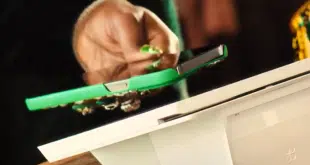It’s where dining out, consumer affinity for self-service, and a desire to know more about consumers converge.
Consumers are expected to spend $736.3 billion—yes, billion—on dining out in 2017. That’s a lot of credit and debit card payments. It’s enough to make the tabletop point-of-sale market a fiercely competitive one, replete with tabletop POS providers, self-serve POS apps, and traditional merchant-services providers all vying for restaurateur and consumer attention.
In years past—prior to the tremendous adoption of smart phones, the greater affordability of POS equipment, and the proliferation of WiFi and Bluetooth—restaurant owners dealt with payments in centralized locations in their establishments. It might be a server who brings the credit or debit card to a POS terminal or system, or customers queueing up to pay. Quick-serve restaurants at least had multiple POS terminals, but still required consumers to line up.
In the era of self-service—evidenced by more consumers willingly making purchases online—restaurant owners find they need ways to accommodate this shift in consumer behavior.
Some vendors, such as Austin, Texas-based TabbedOut, put the whole transaction in the consumer’s app. Restaurant chain TGI Friday’s had used TabbedOut beginning in 2012, but has moved the self-service payment function to its Friday’s app. Others, like TableSafe, focus on the server. Its Rail product enables tableside ordering and payments, even in finer dining venues.
Tabletop POS systems, though garnering much attention, are the least-used payment technology in restaurants, according to the National Restaurant Association’s Restaurant Technology Survey from September 2016. Only 20% of restaurants use the tech, leaving many more that could adopt it. The top choice, a POS or electronic cash register, was used by 81%.
‘It’s All Self-Service’
Yet tabletop options are copious. The conventional product is a pay-at-the-table POS terminal that a server brings to the table so the diner can make a payment. Another option is an app that relies on a stored payment method on a smart phone. Yet another option is a tabletop device for payments and, in some instances, other activities.
It’s this last group of devices—commonly seen in many family-oriented restaurants like Chili’s, Red Robin, and Smokey Bones—that have captured a lot of attention.
Ziosk, the tabletop POS device owned by Dallas-based Tabletop Media LLC, is perhaps the best-known purveyor of these devices. Its latest deployment involves adding 45 more Outback Steakhouse restaurant locations in the Southwest to a franchisee’s existing roster of 62.
That brings to more than 3,000 the number of restaurant locations using Ziosk. They account for more than 170,000 devices. Overall, since its 2006 founding, Ziosk has processed more than $10 billion in transactions.
“The original emphasis for the company was to solve the pain point in table-service dining where the guest has to wait for an inordinate amount of time between wanting the check and getting the check,” says Austen Mulinder, Ziosk president and chief executive. “For Ziosk, the task was to determine if you could put a device on the table to enable people to pay and go in an authenticated way.”
By having devices on the table, you could solve the payment challenge, but you also can solve a lot more. In Ziosk-equipped restaurants, 80% of consumers use Ziosk to pay, says Viren Balar, chief technology officer and founder.
Chief among these other challenges is knowing more about consumers, giving them payment choices, improving table turn, and making it easy for consumers to enroll in loyalty programs.
For example, at the 62 Outback Steakhouse locations in the Southwest that have been using Ziosk devices, the checkout process has been reduced, on average, by seven minutes. Enrollments in the Outback loyalty program increased 10-fold at these locations, Ziosk says.
The Ziosk model also addresses the rising consumer affinity for self-service, Mulinder says. “One of the distinctions between Ziosk and tableside service is that device still requires a server,” he says. “When you have Ziosks it’s all self-service. Frankly, it’s something that guests like to have, that level of self-control.”
‘Line Anxiety’
But not all restaurant POS system providers use the Ziosk model. Other vendors include San Francisco-based Revel Systems, New York City-based ShopKeep.com Inc., TouchBistro Inc., also based in New York City, and numerous others.
TouchBistro, instead of placing a device on tabletops, uses commercially-available iPads and iPad Minis. Founded in 2010, TouchBistro operates in nearly 10,000 venues, says Alex Barrotti, founder and chief executive. “We conduct $5 billion through TouchBistro every year,” he says.
The debut of the iPad Mini in 2012 made tableside ordering practical, he says. “A lot of our restaurants started implementing that,” he says. “We discovered they reaped the benefits of efficiency gains. They can send orders to the kitchen while still at the table.” That translates into quicker service and a quicker turn on the table, Barrotti says.
TouchBistro just introduced a kiosk device to enable consumers to order for themselves, he says. “We discovered the average check size was higher than when ordering from an attendant,” he says of tests made with the device. “It turns out the fundamental issue is you don’t have line anxiety.”
Barrotti describes that anxiety as the feeling of having to speed up an order because other consumers are in line behind you. “When you’re at a kiosk you take more time,” he says. “You spend more money because you don’t feel you have to order and get out of the way.”
Getting consumers to spend more money is always welcome, especially in light of fluctuating overall industry sales. Dallas-based restaurant consulting firm TDn2K says restaurant same-store sales overall in July decreased 2.8% from June. And, fine dining, which traditionally eschews self-service payments, grew in July. Quick-service and fast-casual lost sales.
As sales fluctuate, restaurant owners need to not only have insight into their transaction data, but other information, too. “For us, most customers are trying to solve multiple problems,” says Mulinder.
For example, some owners operate in high-wage states. “One chain had to figure out how their servers could manage more tables with the high labor rates they paid,” Mulinder says. “They moved their servers from managing four to six tables. However, it was mandatory that guest satisfaction not go down.” The increased tips from managing more tables provided an incentive for the servers, Mulinder says.
Others place a priority on the entertainment options available on the Ziosk devices. Anecdotally, the app can capture a child’s attention enough to let the parents order and eat with less disruption. Ziosk’s entertainment apps cost $1.99 per use, with a revenue share for restaurants.
As for the payments aspect of such devices, restaurant owners can use almost any processor. TouchBistro supports six payment processors, and Ziosk is processor-agnostic, though it uses a gateway to ensure transactions are secured. Ziosk charges a pass-through gateway fee.
TouchBistro charges a monthly fee for its service, but adds on no fees to payment transactions. Ziosk charges a fee based on the number of devices and locations. “It’s a pretty variable number,” Mulinder says.
Consumers also have multiple options for payment types, including EMV chip cards and mobile wallets. This flexibility is essential, Barrotti says. When the EMV liability shift happened in 2015, TouchBistro’s sales took off, he says.
Many restaurant operators delayed EMV acceptance because of issues surrounding tip adjustments. Many processors have updated their EMV code to make that process easier. At Ziosk, the total and tip are authorized in one transaction, says Balar. “When we make an authorization call, the tip is already added to it,” he says.
‘A Host of New Products’
The prospects for tabletop or tableside POS service are encouraging. In the same National Restaurant Association report mentioned above, 32% of consumers made a tableside payment and 27% used a touchscreen ordering kiosk. Hopes may be pinned to the 63% that said they are willing to make a tableside payment and the 61% who are willing to use an ordering kiosk.
Enterprising payments companies are ready for this.
“We have a host of new products coming,” says Barrotti. “Some are geared to waiters. Some are geared to dining customers.” But the real future may lie in how attitudes are changing among restaurant operators. “People are realizing they have a choice in the matter,” he says.
One TouchBistro restaurant, the Michael Jordan’s Steakhouse in New York City, used the same POS system for 12 years prior to adopting TouchBistro, Barrotti says. This location uses eight iPad Minis for it servers. “A lot of restaurants we’re getting now have legacy systems, with fees and systems that were breaking,” he says.





